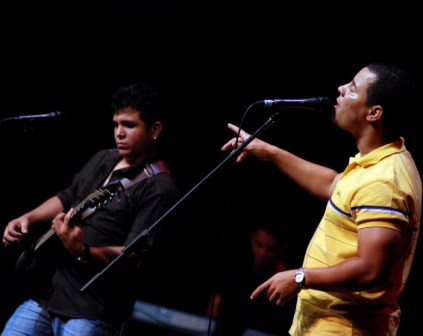Buena Fe and Their CD “Catalejo”
Musical Bridge from Cuba*
Osmel Almaguer

HAVANA TIMES — One of the most successful recordings by the Cuban duo Buena Fe is their album Catalejo (Spyglass) – both from a musical standpoint as well in listening to it lyrics, which are full of satire, reflection and poetry.
Recorded in 2008, this was their fifth of a total of seven albums produced in the last decade, when the group debuted on the Cuban music scene.
On this CD, they realized most of their songs with a high degree of purposefulness. Through them, Cuban essence is defined by their rhythmic sense, as well as from the CD’s semantic, historical and cultural points of view. But there’s also every reason to argue that this is a universal work.
Their songs concern people through time and from all nations, as these compositions deal with themes of love, trust, art and death, among many others. While they are mixed with international rhythms such as rock n ‘roll, pop, ballads, funk and hip hop, they of course still take advantage of the opportunities presented by local rhythms.
The symbolic figure of a spyglass is constituted here as a crucial instrument. Beyond it allowing a critical view of society — to which we are now accustomed to from the young musicians — that new device that is now in our hands gives us a global vision of an indisputable human condition, and with a level of suggestion and notable aesthetic pleasure.
Of the twelve songs included in this production, some stand out more than others because of their intensity, level of suggestion or melody. Such are the cases with “Los barcos en el puerto,” “Cada pais,” “En cueros,” “Lastima,” “Catalejo,” “A la muerte” and “Viernes, sabado y domingo.”
“Los barcos en el Puerto” (Boats in the Harbor), leading the lineup, brings us closer to this strategic point in the city where everything begins and ends (the port), as the point of departure towards new horizons.
It leaves a window open to the second song on the album, “Cada pais” (Every Country), which touches sensitive areas of that other Cuban identity, that of exile, the uprooting, the loss of roots and the impact of borders on the emotional lives of people.
Meanwhile, “En cueros” (naked) is an ode to authenticity, along with being a sociological grievance in which the power and the media bear the brunt. “Lastima” (Shame), with its slow cadence, opens up a whole semantic range of emotions, but it speaks to different types of love, from the carnal to the paternal (with that latter having a likely political reference).
“Catalejo,” the CD’s title track, encompasses the aim of the work and sets the limits and intentions in communicating to the public. It’s here that the duo deploys its arsenal of irony.
They could have ended the record with “A la muerte” (To Death). This song is embodied intensity. Pure passion. Pure poetry. It reminds me of a well-known painting by Carlos Enriquez. Its title? I suppose you already know it.
“Viernes, sabado y domingo,” the next to the last song, is relaxing, friendly – like weekends. Though of course where needs and work abound, weekends don’t look the same.
—–
(*) A Musical Bridge from Cuba: This is an effort to find new bridges that promote communication between peoples of the diverse regions of the planet. I will be using simple narration in a series of articles to connect with those who are interested in the messages transmitted by Cuban songs, which due to their limited commercial potential and the difficulties posed by their translation, languish in a state of communicational stagnation – despite their being true jewels of Cuban culture.





